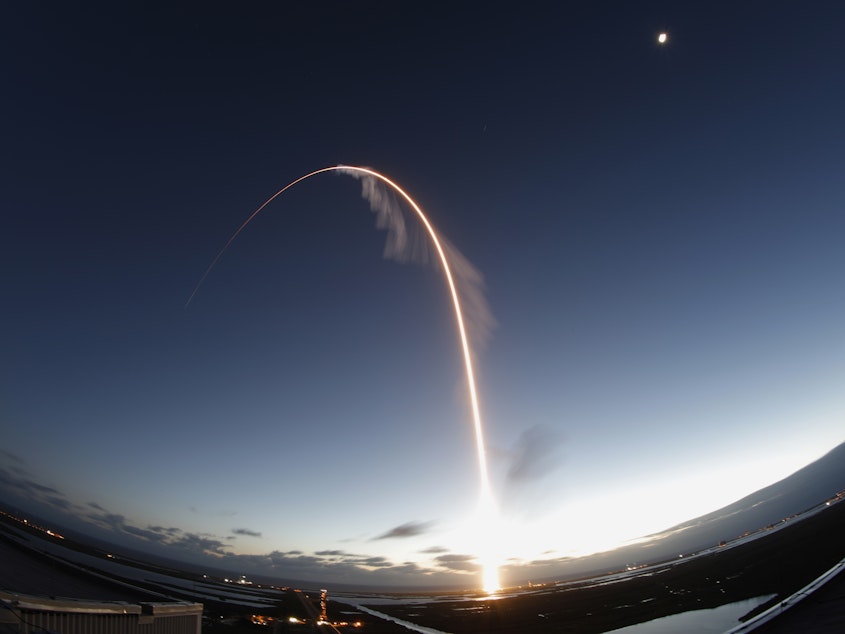In Uncrewed Test, Boeing's Starliner Capsule Fails To Reach Space Station

Boeing's new Starliner capsule, on its maiden uncrewed flight to the International Space Station, has failed to attain its proper orbit after a flawless liftoff from Cape Canaveral, Fla., the company says.
Boeing says the capsule, which is carrying 600 pounds of cargo as a dress rehearsal for a possible mission with astronauts next year, has reached a stable orbit, but not at the correct altitude to dock with the station.
The test is part of NASA's $6.8 billion Commercial Crew program to launch humans from the U.S. and end a nearly decadelong reliance on the Russian space agency for rides to the station. Currently, NASA astronauts hitch a ride on Soyuz capsules.
Boeing is going head-to-head with SpaceX, which conducted a successful docking of its Dragon capsule with the station in March. SpaceX could send astronauts on Dragon as soon as the spring.
Friday's launch of Starliner also comes as Boeing's public image has been battered by the fatal crash of two of its 737 Max jetliners last year and the subsequent global grounding of the aircraft type.
Whether Boeing or SpaceX, when NASA does launch humans from U.S. soil sometime next year, it will be the first time since the last Space Shuttle mission in 2011.
"We're doing it in a way that's never been done before," said NASA administrator Jim Bridenstine. "This time when we go, we're going to go with commercial partners. NASA is not purchasing, owning and operating the hardware. We're buying the service."
It's a lot like calling an Uber to space. NASA is paying for rides to the station, relying on two commercial vehicles — SpaceX's Crew Dragon and Boeing's Starliner.
Originally NASA called for U.S. launches to the station to resume by the end of 2017. The program and its delays date back to its start nearly a decade ago. Funding for the project was awarded in steps, and each round brought new developments and eventually whittled down the companies getting the Commercial Crew contracts to just two.
However, comprehensive congressional funding was lacking. "They were underfunded at the beginning," said retired NASA astronaut Sandy Magnus. "Continually fighting this battle of one-year funding plus getting into these continuing resolutions [in Congress] really stops the momentum of any technical program."
The program has also faced technical issues. Both Boeing and SpaceX rely on parachutes to safely land back on Earth, and testing their design has delayed certifying the capsules for human passengers.
"You wouldn't think that parachutes would be hard. It's a technology that's, that's actually decades old," said space policy analyst Laura Forczyk. NASA has been using parachutes for all of its human space vehicles. "It turns out that it's really hard to make them efficient and reliable.
Boeing and SpaceX both experienced additional issues with their abort systems. SpaceX's Crew Dragon and Boeing's Starliner use engines built into the capsule that fire and push the vehicle — and the astronauts — to safety should something go wrong midflight.
"When you think about these companies designing and building these vehicles, and this is sort of new to them, you would expect to have some technical challenges along the way," said Magnus, who is also a member of NASA's Aerospace Safety Advisory Panel (ASAP) which advises the space agency on safety issues. "From an ASAP viewpoint, that's not really the concerning part. The thing that we watch is just how they're dealt with."
Both companies have responded to the technical challenges. SpaceX has been continuously testing its parachutes. It also says it found the root cause of an explosion earlier this year related to its abort engines. It will test that system next month by firing the abort motors midflight after launching a test capsule on its Falcon 9 rocket.
Boeing completed a test of its abort system last month and called the mission a success. But one of the capsule's parachutes failed to open before touchdown. Boeing said despite the failed chute, if a crew was on board they would land safely. At a news conference this week, Boeing said it identified the cause of the failure and has fixed the issue.
"I think the thing I'm most proud of, with Boeing and both of our commercial crew providers, is as they found issues, they didn't shortcut," said NASA Commercial Crew manager Kathy Lueders. "We all understood that our mission for us to fly crew, we have to fly crew safely."
But the pressure is on. NASA is nearly out of rides to the station on Russia's Soyuz spacecraft, and the last seat is booked for April 2020. Anticipating further delays, the agency said it is conducting "fact finding" discussions to purchase two additional seats from Roscosmos, Russia's state-run space launch provider.
"When you have a new program coming on board like the Commercial Crew Program, it makes sense to make sure we are looking at everything, working out the steps and not putting anybody in a position where they feel rushed," said NASA's deputy ISS manager Joel Montalbano.
Despite the delays, both Commercial Crew companies are nearing the finish line and targeting the first launch of humans on Commercial Crew vehicles early next year.
The same congressional funding that delayed Commercial Crew could affect another NASA priority — returning humans to the moon by 2024. An appropriations bill working its way through Congress doesn't fully fund the program, which could delay that mission into the late 2020s. [Copyright 2019 NPR]



